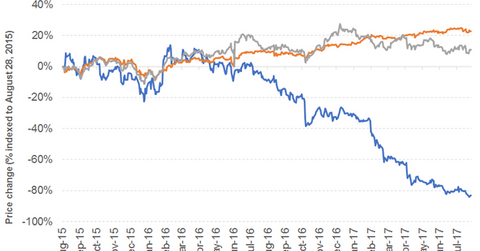Frontier Communications: High Dividend Yield despite Dividend Cut
In this series, we’ll look some small-cap stocks with high dividend yields.
Sept. 11 2017, Published 12:32 p.m. ET

What’s behind Frontier’s high dividend yield
In this series, we’ll look some small-cap stocks with high dividend yields. Let’s start with Frontier Communications (FTR), a US communications service provider. Frontier’s acquisition-driven growth strategy has not contributed much amid the industry’s rapidly progressing technology.
It recorded a significant decline in its customer-related metrics between 2Q16 and 2Q17, mainly due to the traditional phone business gradually becoming obsolete. The acquisition of Verizon Communications’ wireline operations contributed towards impressive revenue growth of 60% in 2016, compared with 17% growth in 2015. However, the growth was partially offset by an increase of 66% in operating expenses in 2016. Operating expenses increased 22% in 2015.
What led to Frontier’s negative earnings per share?
A 38% increase in interest expenses led to negative EPS (earnings per share) in 2016 despite 19% growth in operating income. In 2015, interest expenses rose 60%, and operating income fell 9%, contributing to negative EPS. The Verizon acquisition has played a major role in alleviating the company’s debt. Free cash flow fell due to higher capital expenditure.
Frontier had a debt-to-equity ratio of 4x in 2016. The stock has underperformed the telecom services industry and the S&P 500 (SPX-INDEX) (SPY) by a gradually widening margin, as shown in the chart above.
High dividend yield decoded
Frontier’s revenue and earnings story remained the same for 1H17. While its revenue grew 18%, its operating expenses rose 33%, leading to negative operating income followed by a slight increase in interest expenses and a debt extinguishment loss. As a result, Frontier’s EPS remained negative. The disappointing results led to a slump in its stock price, followed by a goodwill impairment in 2Q17 and a dividend cut.
Frontier stock’s price slump has played a significant role in artificially inflating its dividend yield, as depicted in the chart above. The Vanguard High Dividend Yield ETF (VYM) offers a dividend yield of 2.9%, at a PE (price-to-earnings) ratio of 21.6x. The Vanguard Dividend Appreciation ETF (VIG) provides substantial exposure to industrials. It offers a dividend yield of 2.1%, at a PE ratio of 23.5x. Both ETFs have a 3% exposure to small-cap stocks.
